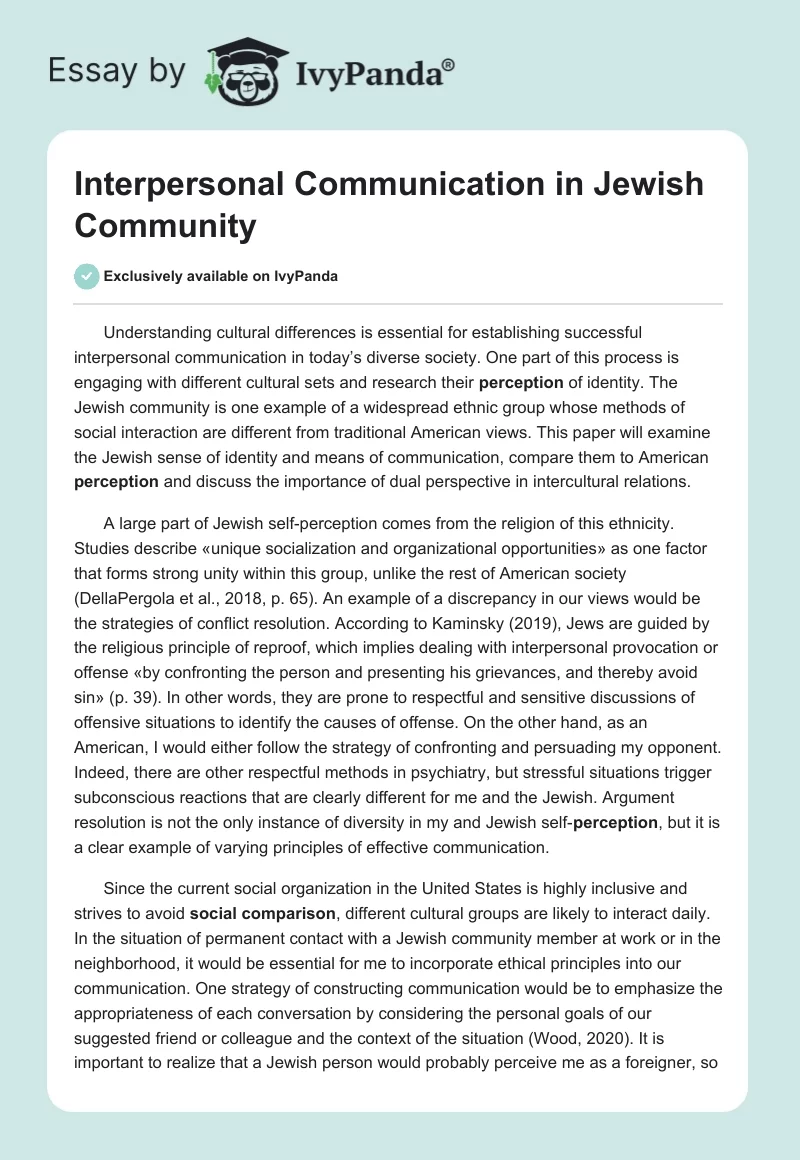Understanding cultural differences is essential for establishing successful interpersonal communication in today’s diverse society. One part of this process is engaging with different cultural sets and research their perception of identity. The Jewish community is one example of a widespread ethnic group whose methods of social interaction are different from traditional American views. This paper will examine the Jewish sense of identity and means of communication, compare them to American perception and discuss the importance of dual perspective in intercultural relations.
A large part of Jewish self-perception comes from the religion of this ethnicity. Studies describe «unique socialization and organizational opportunities» as one factor that forms strong unity within this group, unlike the rest of American society (DellaPergola et al., 2018, p. 65). An example of a discrepancy in our views would be the strategies of conflict resolution. According to Kaminsky (2019), Jews are guided by the religious principle of reproof, which implies dealing with interpersonal provocation or offense «by confronting the person and presenting his grievances, and thereby avoid sin» (p. 39). In other words, they are prone to respectful and sensitive discussions of offensive situations to identify the causes of offense. On the other hand, as an American, I would either follow the strategy of confronting and persuading my opponent. Indeed, there are other respectful methods in psychiatry, but stressful situations trigger subconscious reactions that are clearly different for me and the Jewish. Argument resolution is not the only instance of diversity in my and Jewish self-perception, but it is a clear example of varying principles of effective communication.
Since the current social organization in the United States is highly inclusive and strives to avoid social comparison, different cultural groups are likely to interact daily. In the situation of permanent contact with a Jewish community member at work or in the neighborhood, it would be essential for me to incorporate ethical principles into our communication. One strategy of constructing communication would be to emphasize the appropriateness of each conversation by considering the personal goals of our suggested friend or colleague and the context of the situation (Wood, 2020). It is important to realize that a Jewish person would probably perceive me as a foreigner, so the method of reflective appraisal would not work for this scenario, as it might be considered an emulation. Instead, I would suggest committing to acting ethically: learn certain habits, opinions, and work or life organizational principles (such as their wish to rest on Sabbath) in a respectful and honorable manner. Considering some cultural differences for my everyday decisions is not very hard, so I would act supportively and expect the same attitude in return. I believe this is a way to establish safe and friendly communication with a member of any culture, not Jewish only.
Forming a relationship with a person of a different culture is also an opportunity to engage in a dual perspective. According to Woods (2020), this method allows one to «understand how someone else thinks and feels about issues» (section 1-6c). Discovering the beliefs, thoughts, and perceptions of others is a significant step towards genuine communication and a somewhat intimate relationship. Woods (2020) also calls people unable to take somebody’s perspective egocentric. From my experience interacting with this type of people, they are likely to disregard and lose credibility among their friends. That is the opposite of what I value in communication, so I would carefully practice interpretation of my friend’s feelings and tolerating them. Overall, a dual perspective is an opportunity to earn the affection and trust of people from other cultural groups.
To summarize, establishing a close relationship with a person from the Jewish community would be a careful and exciting process. American and Jewish cultures pursue different methods of conflict resolution, so it would be essential to establish a respectful manner in communication. By evaluating the appropriateness of each conversation, considering each other’s interests, and engaging in a dual perspective, the development of working or friendly communication will be successful.
References
DellaPergola, S., Levy, S., Rebhun, U., & Sagi, D. (2018). The structure of Jewish identification in the United States: 2001 Revisited. In DellaPergola, S., & Rebhun, U. (Eds.), Jewish population and identity: Concepts and reality, (pp. 43-71).
Kaminsky, H. (2019). Fundamentals of Jewish Conflict Resolution-Some Key Elements. Journal of Living Together, 6(1), 33-42. Web.
Wood, J.T. (2020). Interpersonal Communication: Everyday Encounters (9th ed.). Cengage Learning


